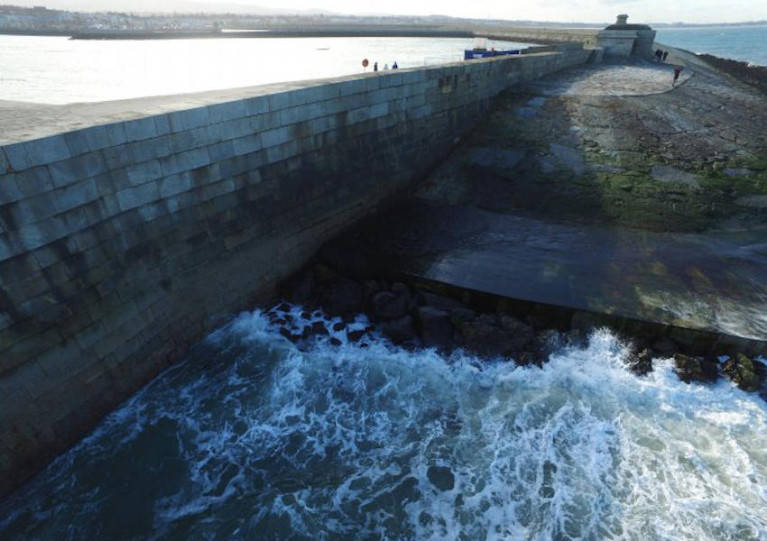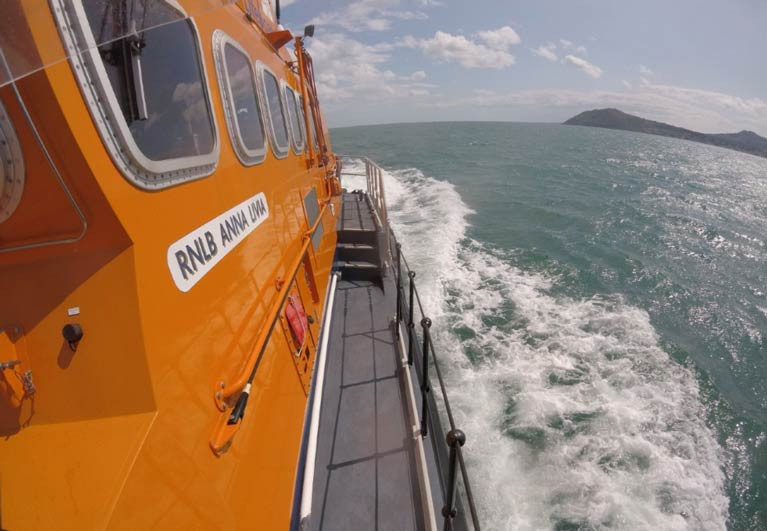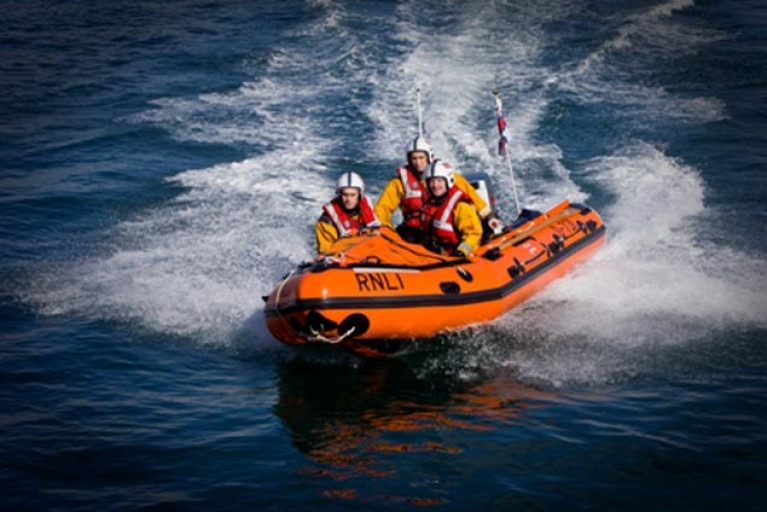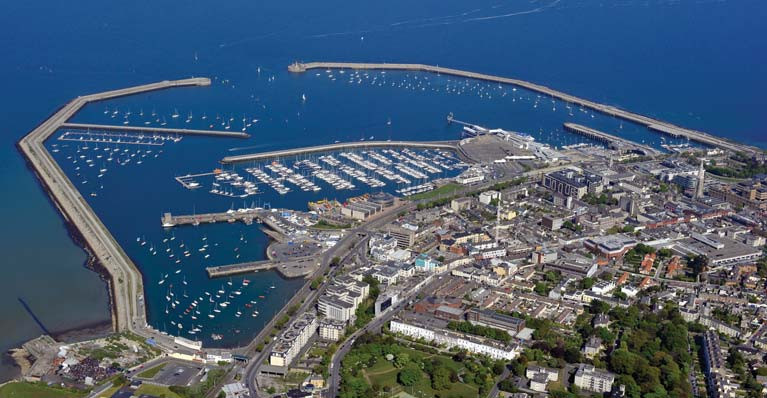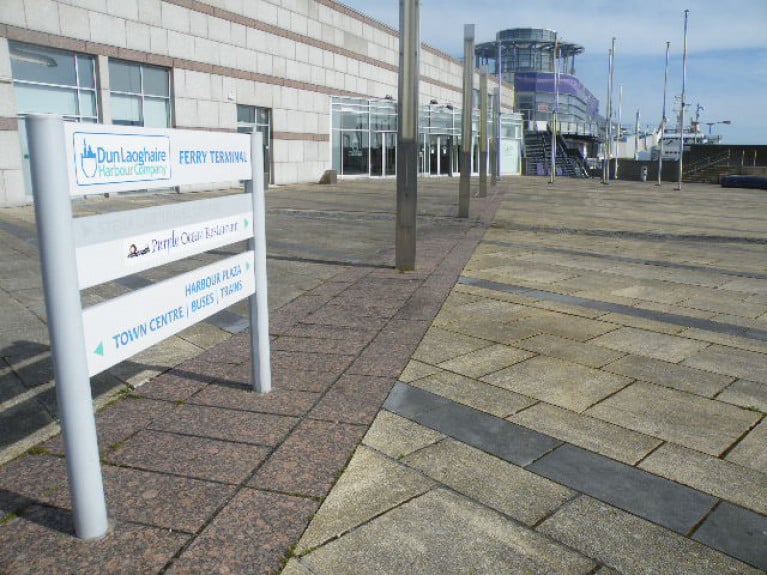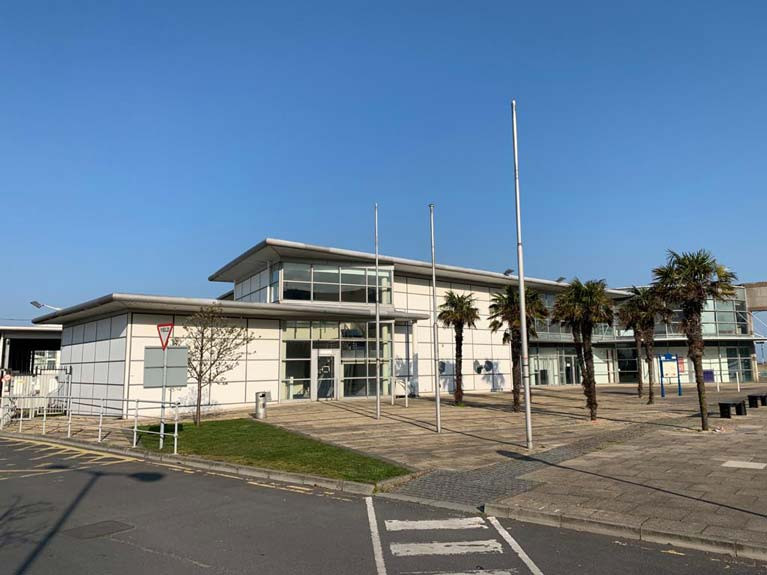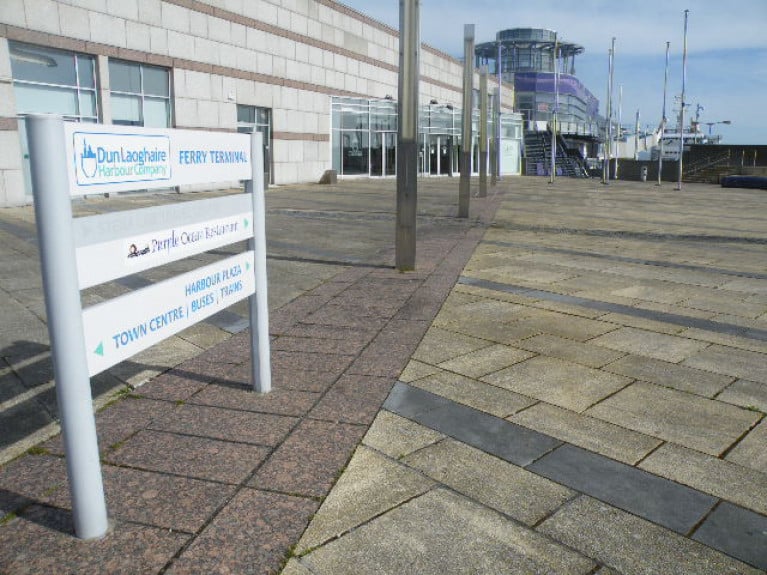Displaying items by tag: Dun Laoghaire Harbour
Works to repair storm damage to the East and West Piers in Dun Laoghaire Harbour during Storm Emma two years ago have now been completed, bar restoration of the sun shelter on the East Pier.
Movement restrictions to control the spread of coronavirus slowed the final weeks of works, which involved repairs to coastal defences on the East Pier as reported on Afloat.ie in early March.
Now Dun Laoghaire-Rathdown County Council has provided an update of the repairs progress over a number of phases, from emergency works to reconstruction of the East Pier’s upper level wall, replacing 400 tonnes of rock armour washed away in the storm, and shoring up the West Pier’s roundhead resentment.
Restoration of the East Pier’s sun shelter remains outstanding and the council says it is features in its Capital Projects plan awaiting funding to proceed.
Despite the Irish Coast Guard advisory asking members of the public not to go to sea for recreational purposes, Dun Laoghaire RNLI all-weather lifeboat was launched on Saturday afternoon (May 16) following a request from the Coast Guard, to assist an 18ft speedboat with three people on board which had reported engine failure half a mile north of Dun Laoghaire Harbour’s West Pier.
The all-weather lifeboat was launched under Coxswain Mark McGibney with four crew members on board and made its way to the scene arriving at 3:02 pm. The all-weather lifeboat took the vessel in tow and brought it back to Dun Laoghaire Harbour, all on board were wearing lifejackets and no medical attention was required.
Weather conditions at the time were described as good with a light wind and good visibility.
Speaking following the call out, Mark McGibney, Dun Laoghaire RNLI lifeboat Coxwain at the time said: ‘The casualties did the right thing calling for help once they knew they were in difficulty. I would like to take this opportunity to remind everybody to make sure that their vessel engines and safety equipment are checked and in working order before taking to the water.’ ‘Dun Laoghaire RNLI remains on call and is fully operational during the Coronavirus pandemic. While there is no crew training or exercises taking place, our volunteers are here if people need us.’
The Coast Guard revised its 'no boating' statement on Friday stating that Under Phase 1 of the Roadmap to Recovery (commencing 18 May), people are permitted to engage in outdoor sporting and fitness activities on an individual basis.
Volunteers from Dun Laoghaire Harbour's RNLI station were involved in a two-hour search operation off the coast of Sandymount Strand last night (7 May), after receiving reports that a person was thought to be seen cut off by the tide on a sandbar. The call-out transpired to be a false alarm with good intent.
The station's volunteer crew were paged shortly before 10 pm by the Irish Coast Guard. The crew immediately launched their inshore lifeboat helmed by Alan Keville and with two crew members on board. The Irish Coast Guard helicopter Rescue 116 from Dublin, Dun Laoghaire Coast Guard unit, the Irish Air Corps and the Gardaí were also tasked.
Weather conditions at sea were good making visibility ideal for searching.
The lifeboat crew arrived at the scene at 10.17 pm and carried out an extensive offshore search with the helicopter. No evidence of a person in the water was found. The Coast Guard stood down the operation at approximately 12 am and the volunteers returned safely to the station.
Speaking following the call out, Dun Laoghaire RNLI Helm Alan Keville, said: ‘We are always here to respond to any situation that may arise at sea and this one was no different. The report to the Irish Coast Guard by a member of the public was most definitely made in good faith we would like to commend them for doing the right thing. While this was a false alarm with good intent, we are glad we had the opportunity to make sure no life was at risk as fast-moving tides and sandbanks have been a problem in this area in the past. This was a multi-agency response and we would also like to commend and thank our colleagues in the various other agencies as we worked together during the search.
‘Dun Laoghaire RNLI remains on call and is fully operational during the Coronavirus pandemic. While there is no crew training or exercises taking place, our volunteers are available if people need us.’
A business stimulus for Dun Laoghaire after COVID-19 may well lie in government approved plans for a national watersports campus in the town's harbour. It comes at a time when town officials seek to regenerate the 200-year-old harbour and give it new purpose after the Holyhead ferry set sail for the last time five years ago.
As Afloat reported in January 2020, Dun Laoghaire Harbour's marine leisure users joined Dun Laoghaire Rathdown County Council to create a new watersportfocus at the south Dublin harbour, the country's biggest boating centre. The 'National Watersports Campus' application was developed following discussion with Dun Laoghaire Rathdown County Council (DLRCoCo), Irish Sailing, the four waterfront clubs, INSS, DBSC and DLCC and also with other NGB’s - Diving, Rowing, Triathlon, Swimming and Canoeing who came together to lift the profile of sailing and boating in the south Dublin suburb.
 The annual Dún Laoghaire Harbour Swim Race - is a 'blue riband' race on the Open Sea Calendar in Ireland Photo: DLR
The annual Dún Laoghaire Harbour Swim Race - is a 'blue riband' race on the Open Sea Calendar in Ireland Photo: DLR
The potential for a twofold increase or more in the boat stock at Dun Laoghaire exists if DLRCoCo can provide the missing infrastructure to promote the marine leisure industry, according to the new maritime blueprint unveiled by the town in its application to the Large Scale Sports Infrastructure Fund (LSSIF).
But despite having the capital's population of 1.4m on its doorstep and some world-class boating facilities, boat ownership remains stubbornly low both on Dublin Bay and around the coast with only one person in 171 owning a boat.
 The Red Bull diving spectacular brought the Dublin crowds out to Dun Laoghaire Harbour
The Red Bull diving spectacular brought the Dublin crowds out to Dun Laoghaire Harbour
Boat ownership ratio
The ratio of our European neighbours is UK 1:100, France 1: 66, Netherlands 1:30 and Germany 1:108. Ireland might be an island nation, yet its low boat ownership is explained away by poor coastal infrastructure and the lack of a necklace of marinas around Ireland but that's not the case at the country's biggest boating centre where other factors are restricting marine leisure growth.
 Dun Laoghaire Harbour is home to a great coastal rowing scene Photo: Afloat
Dun Laoghaire Harbour is home to a great coastal rowing scene Photo: Afloat
In the study, The Potential for Growing Marine Leisure on the East Coast, (ISMS 2006) an estimate of the size of the Irish national boat park at 27,926 boats was established. This gives Ireland a boat ownership ratio of 1:171 or one boat per 171 people. This is the internationally recognised method of calculating the size of the national boat park (ICOMIA) This figure is surprisingly low given that Ireland is an island nation, especially when compared with our European neighbours. UK 1:100, France 1: 66, Netherlands 1:30, Germany 1:108
 Learning to sail at Dun Laoghaire
Learning to sail at Dun Laoghaire
New public slipway
The aim of the Dun Laoghaire Campus project is to provide a vital missing infrastructure to address this ratio deficit. For example, there is no public slipway accessible at all stage of the tide between Dublin city and Bray in County Wicklow or public boat storage facility.
The campus also seeks to provide a marketing framework to make boating more accessible to the general public. When combined with other current plans in the harbour to use the old ferry terminal as a new state of the art business hub it makes the Council's plan an appealing prospect.
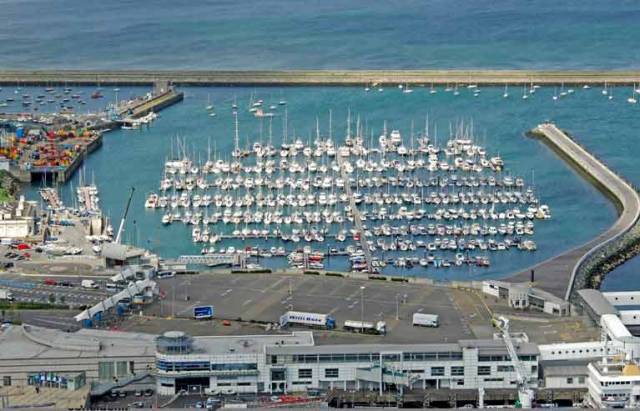 Dun Laoghaire Marina - the town facility has the capacity for over 800 boats and is the biggest marina in Ireland
Dun Laoghaire Marina - the town facility has the capacity for over 800 boats and is the biggest marina in Ireland
Marine jobs
The benefits of such an increase in marine leisure might be obvious to the Dun Laoghaire waterfront as outlined by one leading Dun Laoghaire mariner here but there are other spin-offs for the harbour town too in the creation of the sort of jobs that cannot be shipped abroad.
Think of the former Pfizer plant in Dun Laoghaire; the cost to the Exchequer of each of those 210 or so jobs and the ease with which they upped and left when the Pharma pulled out of the town back in 2011.
For a similar investment, DLR can develop 200 jobs that would stick to Dun Laoghaire Harbour like limpets because this is where their natural advantage would exist.
These employers would not only be in the old-style hunter-gatherer lifestyles (e.g. inshore or sea fishing) but in activity-tourism and niche manufacturing and services.
 The MGM Boatyard hoist in Dun Laoghaire's Coal Harbour lifts the Dublin Port pilot boat for maintenance
The MGM Boatyard hoist in Dun Laoghaire's Coal Harbour lifts the Dublin Port pilot boat for maintenance
As a working, for instance, a sail-making firm was established in Crosshaven, in Cork Harbour in 1974. It s still there, a thriving small Irish business that designs and exports sails all over the world.
It grew thanks to the enterprise of a local initiative by Royal Cork Yacht Club to develop festivals and events such as the world-renowned Cork Week regatta.
Marine skills courses
The Dun Laoghaire campus envisages how the harbour could be used as incubators for sailmakers, riggers, marine electronics and mechanical workshops. Of course, if such efforts bore fruit, it could then lead to employment opportunities and further education courses training young people in marine skills for use locally.
A lot of marine businesses already exist in the harbour in a micro way, currently employing up to 100 people, most of whom work out of vans without proper premises but there is no formal marine cluster that could unite these efforts.
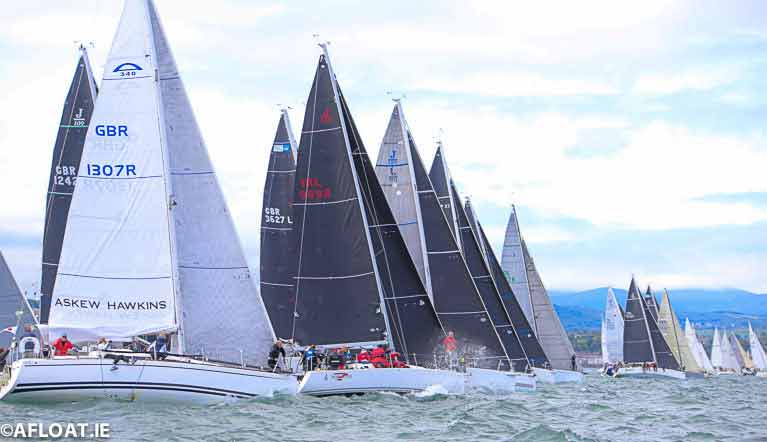 The biennial Dun Laoghaire Regatta attracts as many as 500 boats to the Harbour, up to one third coming from outside Dublin Bay Photo: Afloat
The biennial Dun Laoghaire Regatta attracts as many as 500 boats to the Harbour, up to one third coming from outside Dublin Bay Photo: Afloat
Dun Laoghaire Regatta
In 2010, The Irish Marine Federation (IMF) published a case study on the socio-economic significance of the 2009 Volvo Dun Laoghaire Regatta. The biennial event attracted an entry of 449 entries and is the biggest regatta in Ireland. Over four days, the study (carried out by Irish Sea Marine Leisure Knowledge Network) found the event was worth nearly three million to the local economy. But that is only four days in 730, leaving much scope for further harbour based maritime events.
 Motorboating off Dun Laoghaire's East Pier Photo: Afloat
Motorboating off Dun Laoghaire's East Pier Photo: Afloat
If campus plans take-off the potential to grow the marine leisure industry in Dun Laoghaire Harbour is significant. Attracting new people into the sport would, of course, be a significant lift for existing industry efforts such as the pioneering work of marine entrepreneurs in the boatyard, the marina, the chandlers, the sailing schools and the yacht clubs as major harbour employers. State-backed support would add heft to what is effectively a local industry hiding in plain sight to so many in the town.
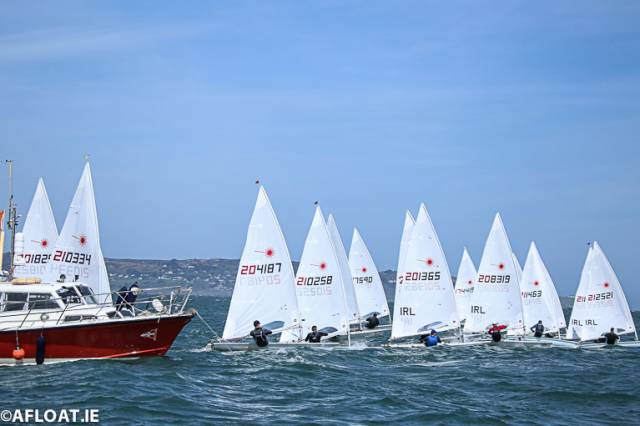 The harbour clubs host many international sailing regattas including the Laser Masters World Championships Photo: Afloat
The harbour clubs host many international sailing regattas including the Laser Masters World Championships Photo: Afloat
The feasibility study – backed by 40 different harbour users including the four waterfront yacht clubs – envisages linking existing clubs and facilities as a campus to promote the sport of boating. As well as providing missing infrastructure it envisages a new municipal watersports building on the town's vacant Carlisle Pier.
Before COVID-19 hit, Afloat's WM Nixon said in January, that Dun Laoghaire was moving into a new era with a fair wind for the National Watersports Campus, let's hope that fair wind is still blowing.
Dun Laoghaire Harbour Bye-Laws Downloadable Here!
Dun Laoghaire Harbour Bye-Laws are downloadable below.
The attached, inter alia, are prohibited and made offences by the Harbours Act, 1996 and persons so offending are liable on conviction to the penalties provided for by the Harbours Act, 1996, Section 6, namely on summary conviction to a fine not exceeding €1,904-60 or imprisonment for a term not exceeding 12 months or both (Section 6(1)(a)) or on conviction on indictment, to a fine not exceeding €126,973-80 or imprisonment for a term not exceeding 2 years or both (Section 6(1)(b)).
Two visiting yachts arrived into Dublin Bay on Easter Sunday afternoon despite COVID-19 emergency restrictions that have closed the town marina at Dun Laoghaire, shut down all local boating activity and put the harbour into lockdown under Government guidelines.
A northeasterly gale is forecast this evening and even though new travel restrictions have been extended to include “the arrival of personal non-national maritime leisure vessels", a visitor can avail of 'port of refuge exemption' if required under the Dept of Health and Dept of Transport COVID-19 regulations.
The first yacht (with GBR Sail insignia) moored at the East bight at Dun Laoghaire at noon. The other visitor, with reefed mainsail and flying the UK's red ensign, tacked around Sandycove and Dalkey in the south of the Bay.
Easter represents the start of the boating season at Dun Laoghaire Harbour but with all four yacht clubs closed and the lift in of boats cancelled too, the waterfront that should typically be a hive of activity was instead silent.
Afloat sources understand one of the boats is hoping to resupply in Dun Laoghaire and its final destination is Scotland.
The Coastguard and RNLI have asked boaters to stay off the water to assist emergency services during the COVID-19 crisis. It is an advisory message that appears to have been well observed on Dublin Bay at least, save for one or two stand-up paddleboards (SUP) and a small number of coastal kayakers during Saturday's sunshine.
How Secure are Dun Laoghaire Harbour Piers?
Donal O'Sullivan muses on the implications of a forgotten financial scandal at Dun Laoghaire Harbour
John Rennie, the eminent Scottish engineer who drew up the original plans for Dun Laoghaire Harbour, was destined never to see them come to fruition. He died on the 4th October 1821, many years before the harbour had begun to take its present shape.
There is not the slightest suggestion anywhere that his death was of anything but of natural causes. “The disease which killed my father was that of the liver and kidneys”, wrote his son, Sir John Rennie, FRS, in his being autobiography. (Sir John later succeeded his father in overseeing the project). There is further evidence of his illness in the minutes of the harbour Board where it was recorded, a few months before his death, that Rennie the Elder was too unwell to provide a report on the progress of the works that the harbour commissioners had been looking for.
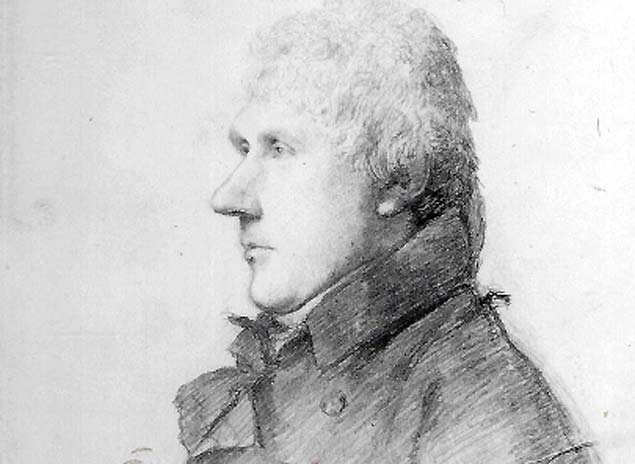 A portrait of John Rennie (the Elder). Reproduced with the permission of the National Portrait Gallery, London
A portrait of John Rennie (the Elder). Reproduced with the permission of the National Portrait Gallery, London
It’s worth mentioning this all this because at one time you could meet locals who would assure you, with the utmost conviction, that “the engineer for the harbour” had put an end to his own life because, allegedly, “he put the piers in the wrong place”. That, to put it mildly, is pure folklore; suffice it to point out that that the only serious question that ever arose about John Rennie’s plans for Dun Laoghaire Harbour concerned another matter altogether - the width of the harbour mouth.
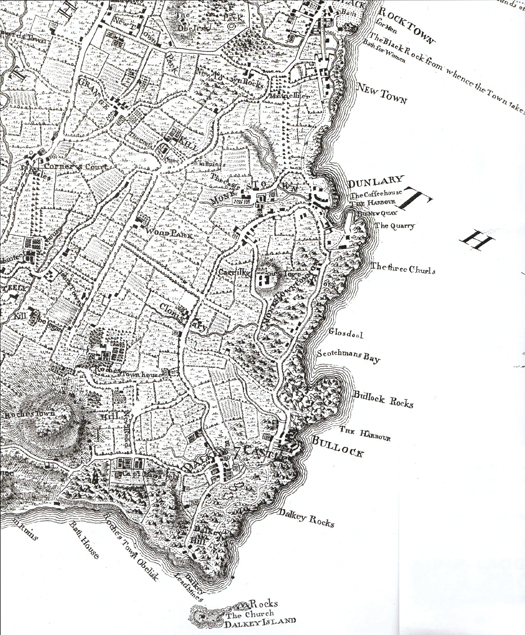 The coast at Dun Laoghaire before the harbour was built. The harbour of Old Dunleary, in the area still known as The Gut, was a shallow creek in the southwest corner of the new harbour
The coast at Dun Laoghaire before the harbour was built. The harbour of Old Dunleary, in the area still known as The Gut, was a shallow creek in the southwest corner of the new harbour
"The entrance was too narrow, they thought, for ships that would have to tack through it"
This was a contentious issue first raised by the captains of the squadron accompanying George IV during his Irish visit. It was too narrow, they thought, for ships that would have to tack through it. The contrary view, argued with much vehemence, was that a widening it would deny vessels inside the protection from easterly winds that was the primary purpose of the Harbour. The argument rumbled on for years and was finally decided when the Admiralty pressurised the Board of Works (by then in charge of the Harbour) to provide a mouth 200 feet wider than that proposed by Rennie. Perhaps the only sensible verdict on the whole matter might be the opinion in a report in 1855 of Captains Kellett and Frazer that “perfect security and facility of access are so antagonistic that one must be chosen”.
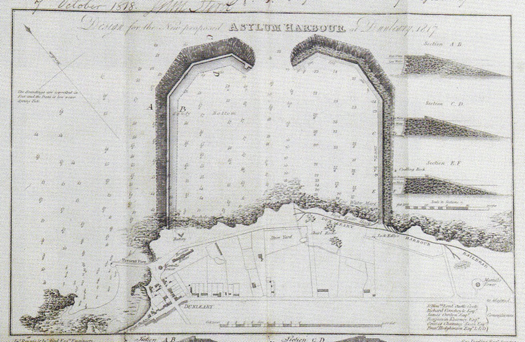 The first plan for the new harbour in 1817. The entrance was made wider in the finished version, and the West Pier was built further west to enclose the Old Dunleary harbour
The first plan for the new harbour in 1817. The entrance was made wider in the finished version, and the West Pier was built further west to enclose the Old Dunleary harbour
All that aside, while few would fault Rennie on his plans for the harbour, how some of those plans were executed is quite another matter – at least on the financial side and possibly on the technical side as well. Early in 1829, a dispute broke out between the harbour board and then - quarry contractors, Sam Smith and Bargeny McCulloch, about the use of quarry rubbish or shingle to cover the beech then existing on the shore between the piers - there were plans for a boat quay. (The original contractor was George Smith who died in September 1825 and was succeeded by his son, Sam, and son-in-law, Bargeny McCulloch).
Smith and McCulloch would have been wiser to have avoided such an argument, because it sent a financial subcommittee of the Harbour Commissioners, who were new to the job, back a to the original contract for working the quarries in Dalkey and delivering the stone to the pier heads.
What they found appalled them. Firstly there was an issue about the proportion of large blocks of stone to rubble stone - five of the former to two of the latter. The original specification on which the contract was based stipulated two to five; the proportion had been reversed by whoever drafted the contract. The large blocks were very valuable, measuring five to two cubic yards. “Many of them”, said the report, “admit of being squared or dressed so as to be used in facing or finishing the piers or quays and for which the contractors are paid 1/3d additional”. The rubble was not to be less than one and a quarter cubic foot. The stone was paid for at 3/- per cubic yard on the amounts of stone excavated “without the delivery being checked or counted in respect of the quantity or description delivered”.
But most serious of all, as they say in their report, the contract “was silent as to quarry rubbish. In fact, the use or disposal of it does not appear to have been contemplated by the contracting parties. Notwithstanding which, immense quantities were applied in the formation of both piers- but more particularly in forming the west pier—and paid for at the rate of 3/-per cubic foot “ i.e the price for the large blocks. To drive home the enormity of this, the authors of the report helpfully points out that in their letter of the 23rd of September 1829 the contractors “have offered to deliver shingle or rubbish to the beach on or between the piers at the rate of 10p per cubic yard”
Further on in the report, there is a curious observation. In criticizing the practice of “of paying the contractor by measurement without reference to the quantity or kind of material is delivered” they add the phrase ”in practice injurious to the stability of the work”.
This offhand, throwaway remark seems to have never received any attention. Understandably, perhaps, with the main focus at the time being on the financial implications which, in truth were quite serious. The report had spelt it out starkly. “Your committee apprehend that if the committee for auditing the public accounts called for the contract - they would disallow the account and report the facts to the government with their opinion thereon”. (Of the stability bit, more presently).
Nowhere in the records is there any suggestion that anyone on the harbourside had anything to gain personally from this maladministration of the contract. Neither of the two Rennies, to whom Dun Laoghaire (then Kingstown) Harbour was just one of many projects occupying their minds. Nor the Harbour Commissioners, local worthies who showed exemplary zeal in protecting the public purse. Nor John Aird, the resident engineer appointed on Rennie’s advice who certified the payments – an awkward, contrary sort of man, you might think from his letters the harbour minutes, who sometimes protected the workforce from the penny-pinching proclivities of the Commissioners. It just seems to have been one of those unfortunate things that happen in organisations when practical, busy men take their eyes of what they too often dismiss as “just paperwork”.
And yet, from the very outset, there was something odd about the Dun Laoghaire Harbour contract. Hardly had it been signed, when the Harbour Commissioners had to deal with a worrisome letter from a west of Ireland contractor called John Behan., directed to the Viceroy, Earl Whitworth He claimed that his tender was lower than that of George Smith, who had been allowed to lower his prices to bring his prices below those of Behan. He intended no disrespect to the Harbour Commissioners; he just felt that their judgement had been influenced by Rennie in favour of his fellow-countryman” (ie Smith).
Behan’s letter contained a sentence which the Commissioners must have found unsettling: Behan presumed “to think that Your Excellency may also think this matter to be of public importance, involving the integrity of public competition so eminently upheld during Your Excellency’s administration”
But Rennie deal with this smoothly enough. He, for his part, intended no disrespect to John Behan, with whom he was personally unacquainted, but he made no bones about his partiality for Smith, who had long experience in the quarrying, dressing and removing stone in the neighbourhood of Bulloch, and who had long skill in the execution of masonry of this sort. He had also a large number of workmen employed in the quarries in the neighbourhood; he, Rennie, had personal experience of the excellence of Smith’s work when he worked for him on the Howth Harbour project. There was also his fear that a higher price would have to be paid should Behan fail in the execution of his contract. Ultimately it came down to whether the commissioners had confidence in Rennie’s judgement and on that there could be no doubt or argument.
For good measure, the Harbour Commissioners added their own few tuppence. After tendering Behan, apparently, had asked that his proposals to be returned to him and then informed them that he intended increasing his prices by 12 1/2 %, which gave the Commissioners the impression that Behan did not really know what he was getting himself into.
As to the assertion that their decision “was influenced by persons in their employ in favour of their countryman Smith,” they added that they “submit that so gross and unfounded an insinuation is best repelled by the well-known honour and integrity of Mr Rennie”.
Then there was the curious matter of John Aird and Alexander Nimmo, a dispute that the Commissioners had stumbled into inadvertently. In October 1817, as the work had begun to get underway, the Commissioners appointed Nimmo, another engineer, to conduct a survey of the quarries. Aird took umbrage, claiming that the appointment undermined his own authority. He wrote a most intemperate letter to the commissioners, telling them, inter alia, how much he despised the motives that inspired the appointment.
Very much taken aback at what they had unloosed, the Commissioners asked Rennie, who had appointed Aird, what he thought. Rennie confirmed that Aird’s authority would indeed have been undermined – and indeed reflected on himself - but the letter was most unfortunate and he then diplomatically made some procedural proposals that would meet the Commissioners requirements. Nimmo soon departed, job done, supposedly, and the controversy died down. But thirteen years later, the Commissioners must have wondered whether they should have stood their ground and insisted on independent verification of what was happening at the quarries
And all this quarry shingle “immense quantities - used in the construction of both piers” which “in practice” was “injurious to the stability of the work”? The stability element, in fact, never seems to have trouble anyone overmuch, certainly not Rennie himself – Rennie fils, that is – who in a report of his site visit soon after the Commissioners’ discovery, did not mention it all.
Both the Rennies, in fact, took great pains in securing the foundations of the piers and laying down the glacis, the seaward stone slope that protects the walls of the piers. Rennie pere himself had even specified the type of mortar to be used underwater: pozzolana – a mixture of lime and volcanic ash, used in pier construction since the days of the Caesars. Not the Naples variety, he emphasises but material from another site near Rome, Cavo di San Pablo.
But now since the storm of early March 2018, that phrase “injurious to the stability of the work” has taken on a certain relevance. The West Pier took quite a battering part of the plinth of the DBSC Hut having been swept away. But at the East Pier, such was the force of the wind and wave that the sea penetrated the top of the glacis, allowing the water to gain the interior of the East Pier and the waves that penetrated the interior of the pier met no resistance - except perhaps shingle - burst open the paving at the shelter on the upper walkway. On the whole, however, the pier walls stood firm and Dun Laoghaire was spared on this occasion the type devastation experienced across the channel.
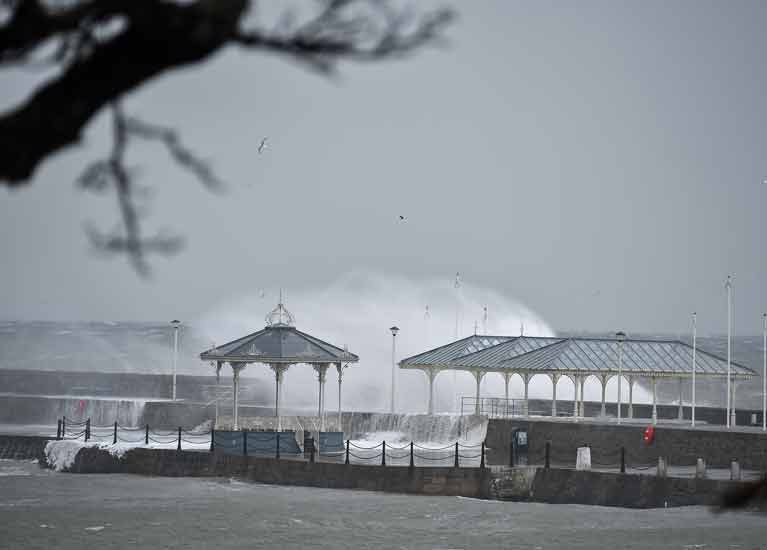 Waves lash Dun Laoghaire harbour's East Pier during Storm Emma causing substantial damage below. Photo: Michael Chester
Waves lash Dun Laoghaire harbour's East Pier during Storm Emma causing substantial damage below. Photo: Michael Chester
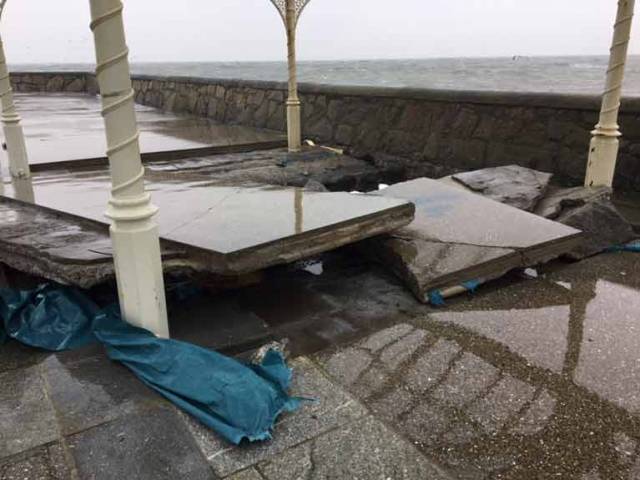 The broken surface at the bandstand area of the East Pier following Storm Emma in March 2018
The broken surface at the bandstand area of the East Pier following Storm Emma in March 2018
Given the current assumption that gales of this variety are likely to occur more frequently in the future, is it reasonable to accept that Dun Laoghaire Harbour will continue to be able to withstand the extremes of weather that are supposed to come our way? Knowing what’s inside some parts of the piers, you might wonder.
 Repair work shows the extent of storm damage to the East Pier Photo: Afloat
Repair work shows the extent of storm damage to the East Pier Photo: Afloat
Coming back to the matter of the Smith contract – the firm had become Smith and McCulloch since the founder George Smith had done in September 1825 - things could not continue as before. There was a legal problem, however in cancelling the contract and the Solicitor-General was not optimistic that the jury would find in the Board’s favour in relation to some aspects of the dispute. In fact, everyone involved was tainted to some extent, including the Commissioners had acquiesced in paying the account and their resident engineer who had signed it. There was also the matter of the thirteen years during which the irregularities had gone unchallenged.
However, he recommended an expedient: oblige the contractors to adhere to the strict letter of the contract and deliver large block stone and rubble at the proportion of five of the large stone to two of rubble. This was clearly impossible and the Smith and McCulloch, recognising that the game was up, withdrew from the contract on the 25th January 1830. A new quarrying contract was later signed with another firm, Henry Mullin and McMahon.
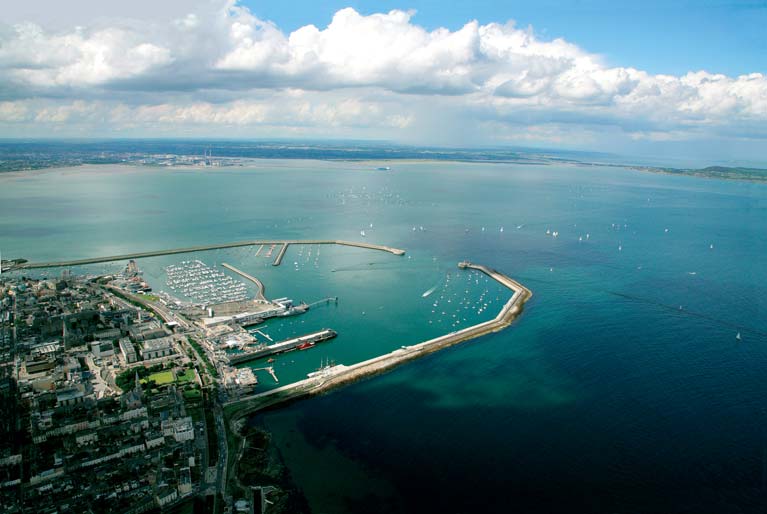 A view from the south looking over Dun Laoghaire Harbour Photo: Peter Barrow
A view from the south looking over Dun Laoghaire Harbour Photo: Peter Barrow
The Board of Works took over Dun Laoghaire harbour on the 31st July 1832 and in the name of efficiency immediately made a clean sweep of the entire harbour establishment. (You might wonder if they knew what had been going on in the quarries) Aird’s salary was reduced from £500 to £300; they were not reducing Mr Aird’s salary as such, they told him –they were just announcing their intention to employ an engineer at £300 a year. Aird was possibly under some stress at the time. He had a stroke some months later- on the 26th November and died on the 8th October the following year.
"His request of a loan of a cart to bring his belongings to Dublin was turned down"
George Darling, the very able secretary and accountant to the outgoing board, was dismissed, there be no longer any need for his services. He went blind at this time and was being assisted by his son, Charles. His request of a loan of a cart to bring his belongings to Dublin was turned down.
The Board of Works testimonial read: “ He has performed his duties in a most efficient and praiseworthy manner”, adding the ungracious qualification “as far as their limited knowledge of the affairs of the harbour will admit them to form a judgement”. Darling must have got some satisfaction a year or two later when they had to send him quite a polite letter asking for his help with a legal issue.
And the Smiths? They went into house building and some of their houses are still standing today. Not unexpectedly, their building methods could be open to scrutiny. One house owner, failing to drive in a nail into a wall to hang a picture, found behind the plaster a block of granite. From Dalkey quarry no doubt. A few feet away, no problem at all – just shingle mixed with horsehair.
Much of the above first appeared in a book on the history Dun Laoghaire written in Irish by the former Hon. Secretary – O Kingstown go Dun Laoghaire. It was published in 1976 by Foilseachain Naisiunta Teoranta
The sources are chiefly the minute books of the proceedings of the Commissioners of Kingstown Harbour, Board of Works, National Archives: OPW Piers & Harbours. Part 1. 1/8/6/1-5 and 1/8/7/1.
New Ferry Terminal ‘Innovation Space’ Plans Could Create More Than 650 Jobs In Dun Laoghaire
More details have emerged of new plans for a technology hub at the site of the former Stena ferry terminal in Dun Laoghaire.
Lapetus Investments Ltd, trading as Quarterdeck Innovation, envisions a “co-working innovation space” within the St Michael’s Pier terminal building in Dun Laoghaire Harbour.
It intends “to create a technology hub whereby small and medium-size businesses can collaborate in a community-based environment that promotes and fosters entrepreneurship, through a spirit of innovation and creativity”.
The project team is led by accountant Hilary Haydon, a past president of Dun Laoghaire-Rathdown Chamber of Commerce and DLR Local Enterprise Office evaluation committee member.
And it’s hoped the scheme could create more than 650 jobs after five years in the south Dublin port town — which will pique the interest of the waterfront yacht clubs among many other local stakeholders.
 From Ferry terminal to state-of-the-art innovation campus - plans are in place to transform the old building Photo: Afloat
From Ferry terminal to state-of-the-art innovation campus - plans are in place to transform the old building Photo: Afloat
Key benefits touted by Quarterdeck Innovation include generating value of €10 million to Dun Laoghaire-Rathdown County Council over its first 10 years, as well as a local spend of €5 million annually.
And the project emphasises integration with its location, positioning the hub as particularly attractive for marine technology and research.
Lapetus/Quarterdeck intends to repurpose the building’s interior as a “state-of-the-art innovation campus” proposing “sensational sea views from almost every desk”.
In addition, its ground floor level would be a ‘Food Hall’ acting as a common area for co-workers to relax away from their desks, and which would also be open to the public as “an opportunity for strong local community interaction”.
The project partners have also pledged to “assist and collaborate closely” with the feasibility study team for the National Watersports Campus being proposed for Carlisle Pier to help “improve the harbour’s infrastructure resulting in improved access, job creation and strong tourism potential”.
Proposals to develop the former Stena ferry terminal were first made in 2017 but later scrapped over licensing issues.
Much more recently, the site has been suggested by a local senator as a base for a Covid-19 testing centre amid the current coronavirus pandemic.
Dun Laoghaire Ferry Terminal Suggested As Covid-19 Testing Site
A Dun Laoghaire senator has suggested that the currently vacant ferry terminal at the south Dublin harbour be employed as a Covid-19 testing centre.
In a letter to Dun Laoghaire-Rathdown County Council chief executive Philomena Poole, as seen by Afloat.ie, Senator Victor Boyhan says the St Michael’s Pier terminal building “would be ideal as a drive-in Covid-19 testing and support centre”.
He outlines a number of reasons for this, which include “its proximity to population along the east coast, its size, facilities and car capacity, and that it is disconnected from the principal residential quarter of the town”.
He continues: “Planning permission would not be an issue, given the emergency powers in place to deal with the Covid-19 pandemic and the temporary nature of the use.
“The harbour terminal buildings extend to about 7,000 sq m (75,000 sq ft) with large, open-plan internal spaces and a wide range of facilities on the site.
“The property has 95 car-parking spaces for occupiers and visitors along with additional roll-on-roll-off car standing facilities that were put in place for the car-ferry service.
“Public transport including the Dart and a number of Dublin Bus routes are within a two-minute walk of the complex, so the site is very accessible to the general public – an important consideration.
“In simple terms, the site is ideal as an emergency Covid-19 testing and support centre.”
Senator Boyhan adds that he had contacted HSE bosses and Health Minister Simon Harris suggesting they explore the suitability of the site with DLRCoCo.
Dun Laoghaire Ferry Terminal Plans ‘Could Be Trojan Horse For Unsuitable Development’
Dun Laoghaire Harbour is on the verge of an investment and development boom — but the unknown provenance of one investor in a key waterfront asset gives pause for thought, writes local resident Paddy Shanahan.
Lapetus Investments Ltd has submitted a planning application to take control of the former Stena ferry terminal by way of a 15-year lease which Dun Laoghaire-Rathdown County Council will be voting either for or against on Monday (10 February).
The investor has also applied to change the ground floor restaurant, in plans for a mixed-use co-working space agreed last year, to a food court — a move backed by at least one local stakeholder.
Readers will be aware that several hundred different stakeholders have agitated for Dun Laoghaire Harbour to be developed as a marine sports campus. And the Council Executive have recently agreed that a marine sports campus is the future for Dun Laoghaire Harbour.
Opening the harbour to the general public paves the way to regeneration of the town centre and an investment thesis that will open up many opportunities bringing in many investors.
Less than two weeks ago, €400,000 was secured from the Government for a feasibility study on the marine campus project; the follow-on investment would be many millions and a boon to Dun Laoghaire.
The terminal building is the jewel in the crown and will be at the centre of proposed marine sports-related initiatives and/or businesses.
However, Lapetus Investments are unknown, and provide no information about themselves only that they wish to build an innovation hub. That should be unacceptable to elected councillors.
The terminal building is the jewel in the crown, and will be at the centre of proposed marine sports-related initiatives and/or businesses
Any development in the harbour and its historical and protected assets should require full disclosure and prior discussion. Anything less is a disservice.
Extremely worrying, and a major red flag, is their application to remove condition number two of the previously granted planning permission, which was placed to ensure the development remains compatible with the Dun Laoghaire-Rathdown County Development Plan 2016-2022.
From the DLRCoCo documentation, the condition states: “This permission shall be for a period of 10 years from the date of the final grant of permission. Four years from the final decision date, the Applicant shall submit a full review/monitoring report, together with floor plans, in respect of the permitted use detailing the overall use and corresponding floor area, demonstrating that the development remains consistent with the particulars of this permission.
“At the end of the 10-year period, the use of the building shall cease unless, permission for its continuance and/or change of use (as required) has been granted by the Planning Authority or An Bord Pleanála on appeal.”
A technology hub is worthy of serious consideration. However, under the terms of their application they wish approval for, Lapetus could use the proposed tech hub as a Trojan horse for other development which goes against all principles of what we, the council and many others are fighting for.
Their application precedes the grant of the feasibility study funds. As such, any vote needs to take place only after the feasibility study is complete and more is known about Lapetus.
Any councillor who votes for granting this lease will be doing so against the wishes of a great many residents of Dun Laoghaire-Rathdown.
All stakeholders in the harbour should remain vigilant on this issue, and I urge all who would agree to pass their concern on to DLRCoCo councillors and urge them to vote against the application until all the facts are clear and the study is complete.



























